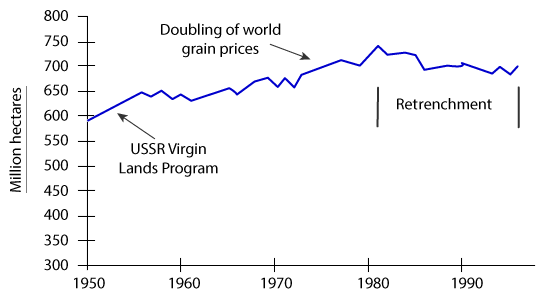Graph Writing # 181 - Area of land from which grain was harvested
- Details
- Last Updated: Wednesday, 26 August 2020 00:00
- Written by IELTS Mentor
- Hits: 37893
IELTS Academic Writing Task 1/ Graph Writing - Line Graph:
» You are advised to spend about 20 minutes on this task.
The graph below shows the area of land from which grain was harvested. Write a report for a university lecturer describing the information in the graph.
Summarise the information by selecting and reporting the main features, and make comparisons where relevant.
» You should write at least 150 words.
World grain harvested area, 1950 – 96

Sample Answer 1:
The line graph gives data on the grain harvesting areas worldwide over a period of 46 years, commencing from 1950. As an overall trend, the area of land in which the seed was cultivated throughout the world increased during the period and land programmes initiated by the USSR, grain price increase and retrenchment affected the land area in which farmers grew the crops.
As can be seen from the given line graph, just below 600 million hectares of the land area was used to grow different grains in 1950 and the USSR Virgin land programme initiation positively affected the total lands devoted to cultivating grains. This programme was initiated around 1955 and as a result, the total cultivable lands increased to around 650 million hectares in 1960. In the next ten years, the total grain harvesting lands gradually increased with some minor fluctuations. The grain price doubles in 1975 and due to this the land for grain harvesting also soared to the peak with approximately 750 million hectares. The retrenchment affected negatively to the land area for grain harvesting and reduced the land to around 700 million hectares in 1990. With some oscillations, the total grain harvesting lands stood at just over 700 million hectares after 1990.
[Written by - Olivia]
Sample Answer 2:
The line graph presents data on the worldwide grain harvesting area from 1950 to 1996. As is clear from the given illustration, global grain harvesting areas increased gradually and grain price, land programmes and retrenchment had effects on the land area where grain was harvested.
According to the given illustration, just below 600 million hectares land was used globally to grow different crops. The USSR Virgin Lands Program was launched after 1950 and it increased the total land area for agricultural cultivations. The gradual increases with some fluctuations could be observed over the period and in 1970, harvested land area amounted over 650 million hectares. The grain price was doubled around 1974-75 and that contributed towards increasing harvesting areas. The highest land area for harvesting could be observed in 1998 when it was about 750 million hectares. From 1980 till the year 1996 retrenchment decreased the global harvested area and in 1996 it was around 670 million hectares.
[Written by - Mike Jones]

Overall, the annual figure of grain harvesting area was affected by 3 major programs and events and gradually increased throughout the period.
To begin with, just less than 600 million hectares of land was used to cultivate grains back in 1950. As the USSR Virgin Lands Program was initiated, the figure increased to 650 million five years later before dropping to 630 million in 1960.
The following decade witnessed a total area of grain harvesting land surpassing 650 million hectares, though no special event took place back then. Again in the 1970s, the world grain price doubled and as a result, harvesting land reached the highest point in 1980 at just below 750 million hectares, 150 million more than that of 1950s.
However, the event of retrenchment brought about negative effects and put a stop to the rise of grains harvested land. Instead, the figure dipped below 700 million hectares since 1983. Finally, in 1996, global harvesting area was around 690 million.
Report